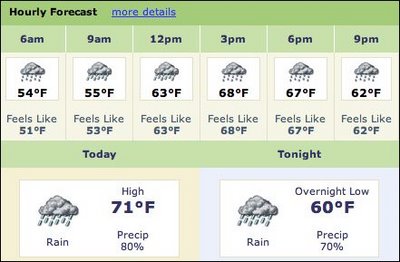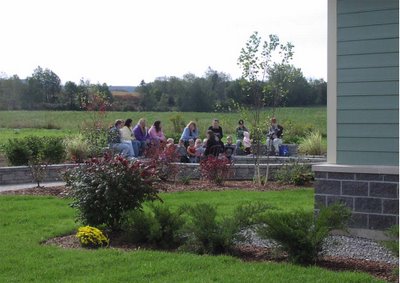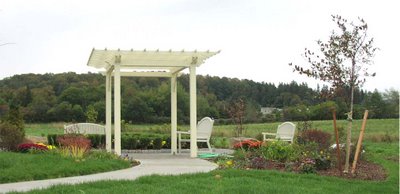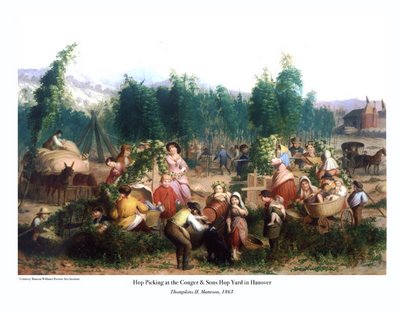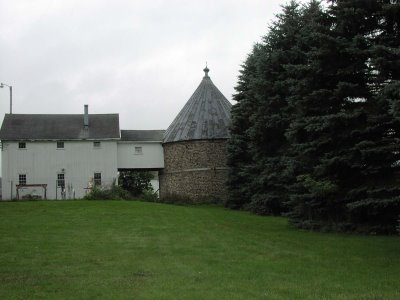Don't forget to put the garbage out!!
56 degrees and it's going to be another great day, but watch out!


A gentleman who lives on East Bacon Street is kind enough to write to say that his Humming Brids are still there --- usually they leave around the first of September. I asked if this was in any way an indication of Weather-to-Come and he has - equally kindly! - promised to let me know: next April!
The next cold front arrives Tuesday with bands of showers and thunderstorms producing locally heavy rainfall. Behind the front it turns blustery and cooler with highs ranging from the upper 40s over the higher terrain to only near 70 in the coastal cities.
It'll be nice and warm in Boston ............ and pretty darned chilly in New York!


Village Board Meeting at 7:00 P.M.
in the Municipal Hall.
Sandy Martin of Sangerfield wrote that she had spent some time, yesterday morning, making decorative swags from hops grown by her mother, Mrs. Furness, and that she'd developed an itchy rash on her hands and arms.
They don't show in this photograph, but I think that's exactly why Hop Pickers wore long-sleeved "HOP GLOVES!!"
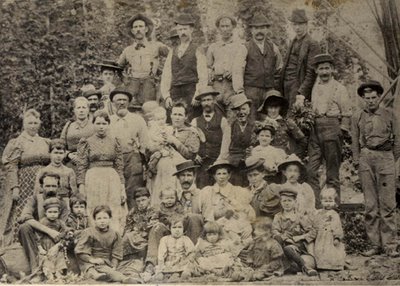
All of the old photographs that I use in this blog are from the
Archives of the Waterville Historical Society as are Historic Writings
- like this one:
The Waterville Times
September 16, 1875
HOPS AND HOP PICKERSHow They Enjoy Themselves
(From the Hamilton Republican)At four o'clock A.M., or as soon as the first streaks of light flow from the east, the clatter of the hop wagons are heard. Every street of the town is visited, and clatter, clatter, bang sharp and anxious, sound the wagons, one following another through every street, seemingly on purpose to wake all sleepers, and warn everybody of the passing hop harvest. Pickers have to crawl out, very many of them, no doubt, yet wearied from the past day's work, and more still, by the past night's revelries, and they begin to "load up". All manner of vehicles are used, from the heavy lumber wagon, with boards across the box for seats, or perhaps a rack seat around the vehicle, to the many seated spring wagons, made expressly for the purpose, which carries from ten to thirty, perhaps, and the elegant platform spring wagon, which carries from five to ten pickers with so much ease and comfort. Then back they go through the streets, the clatter reduced to a rumble by the load obtained, with occasionally a shrill voice heard as some boy more than usually wide-awake calls to a mate, or a loud "Hollow" to call some belated picker to their work. The teams all passed and away, silence settles for an hour or so upon the village before those left at home resume their usual avocation, and those somewhat broken in upon by the encroachments of the hop-raisers who take not only all the available women and children, but often draw largely upon laborers of all classes to aid in securing the crop. With so many gone, the village seems half deserted until the return at night.
The various wagons, well freighted with pickers, hie away countryward one, two or three miles, arriving at the hop yards by the time it is light enough to see clearly, and the work begins. Hops picked in the dew lay up higher in the boxes, and fill up faster than those picked in the heat of the day. Those who go out this early, long before breakfast, "mean business." They work with a will, and many a picker, when hops are choice and the circumstances favorable, picks the larger part of a seven bushel box before breakfast, which usually comes about seven o'clock. Up to this time the yards have been rather quiet, but after the morning meal, and all hands have commenced the day's work , it is no uncommon thing for the song and jest to go round, for shrill voice to answer voice, and screams of laughter answer the cutting joke, the well told story or the pleasant song, and still the nimble fingers keep on, and pluck by ones, twos, threes, and handfuls, the aromatic, good-fornothing produce of the vine. What though the pestiferous insects abound, "hop merchants" are plentiful, or bugs, spiders, worms and such are thick was spotters. The delicate young lady, who in her parlor at home feels in duty bound to scream at one of them, now recklessly dashes them aside by scores, and covered to the elbows in "hop gloves" handles insects and worms with impunity, or with only a sudden quiver of disgust and fear. By high twelve, not one in the yard but welcomes the sensation caused by the summons to dinner. In the long dining room, constituted perhaps with due reference to such an occasion, the tables are elaborately spread. All the substantials and luxuries of the season are prepared. The one who sets a meager or poor table one year, finds it hard work to get pickers the next one, therefore if the housewife has skill and ingenuity, they are in full exercise now. the groceries have yielded their choicest stores, the fields and orchards have been put under contribution, and such a dinner, to be thanked on one side by a splendid tea and on the other by a sumptuous breakfast. Roasts and boils, beef, fish, land and fowls, with such gravies, beautiful, mealy potatoes, and light, snow-white bread, rolls, or bisquits form the substantials, while mountains of cake, oceans of pie, pudding, custards, and often creams and ices, all in the nicest, choicest style serve to whet and appetite which needs no stimulation further than the work in the open air, and the aroma of the hops so freely given. Dinner over, to the yards again, and the afternoon passes like the forenoon, each one trying to gather from the company the greatest amount of enjoyment. Supper over, and hour or two in the yards and encroaching dusk winds up the labor, but in many cases only opens anew the enjoyments of the season. The hop-wagons return to the village those they gathered up in the morning, and as they come in we often hear such roars of laughter which betoken free hilarity and boisterous enjoyment, and at other times it seems as if the throat of each individual in the load was about to burst with the streams of song and chorus with which they "drive dull care away."
With those who stay at the hop grower's over night, is now told the story of those trunks and marvelous large satchels and bags which we see with every party of hop-pickers which comes from abroad. Work over, and hour is given to dress and fixings. The metamorphose of the disagreeable looking caterpillar into the gorgeous butterfly is not astonishing. Silks and satins or more light and airy wardrobes take the place of calicos, bright jewels glisten, and of times gathered in a convenient place, from far and near, to strains of choice music, merry dancers glide, and "Soft eyes Look love to eyes which speak again And all goes merry as a marriage bell."
In the small hours of morning the dancers return to their temporary homes and with the advent of the morning sun, again attired in working garb, they pick, friend discussing with friend, and boxmate with boxmate, the scenes and incidents of the day and night just spent; and thus the days go over and over again.
